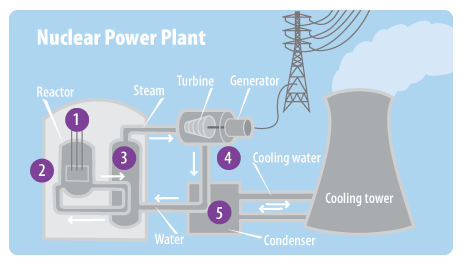Nuclear Energy

Atoms are tiny particles that make up every object in the universe. The bonds that hold atoms together contain a huge amount of energy. When atoms are split apart, this energy can be used to make electricity. This process is called nuclear fission.
In a nuclear power plant, fission takes place inside a reactor. Most nuclear power plants use uranium as fuel because its atoms are easily split apart. Uranium is a metal found in rocks all over the world. Although uranium is not a renewable resource, fairly large quantities of it still exist, and it only takes a small amount to produce a lot of energy.
Because nuclear power plants don't burn fossil fuels, they don't produce greenhouse gases. But mining and refining uranium requires large amounts of energy. In addition, nuclear power plants produce waste that is radioactive. This waste has to be handled and disposed of according to special regulations designed to protect people and the environment.
How It Works

- In a nuclear reactor, fuel rods full of uranium pellets are placed in water.
- Inside the fuel rods, uranium atoms split, releasing energy.
- This energy heats water, creating steam.
- The steam moves through a turbine, which turns a generator to create electricity.
- The steam cools back into water, which can then be used over again. At some nuclear power plants, extra heat is released from a cooling tower.
Cool Facts
- Finding the fuel. One square mile of earth, one foot deep, typically contains over a ton of uranium. A ton of uranium can produce more than 40 million kilowatt-hours of electricity, which is equal to burning 16,000 tons of coal or 80,000 barrels of oil.
- Powering Europe. France gets more than 75 percent of its electricity from nuclear power. Belgium, Sweden, Lithuania, and Ukraine also get large portions of their electricity from nuclear power.
- Where you live. The United States has 104 nuclear reactors, which produce about one-fifth of the electricity generated in the United States. Does any of your electricity come from nuclear power? Check out the map to see where nuclear power plants are located.